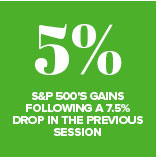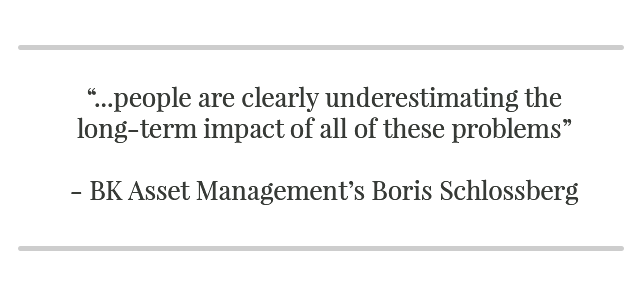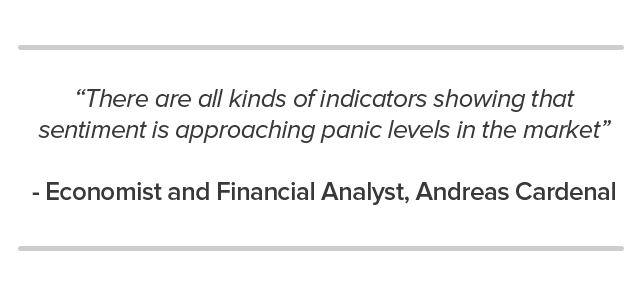
Thursday, March 19, 2020
Signs of a market opportunity: Is now the time to ‘buy the dip’
تم إعداد هذا المنشور من قبل سنشري للاستشارات


Signs of a market opportunity: Is now the time to ‘buy the dip’
The current whipsaw state of the markets may provide opportunities for those willing to buy the dip. But while buying an asset after it’s declined in price can be profitable in long-term uptrends, it can be a lot tougher during downtrends.
Everyone loves a bargain. However, when global markets are crashing out and some analysts are touting the end of a historic bull run, it can sometimes seem counter-intuitive to be buying when everyone else is selling.
Following the worst sell-off since the global financial crisis on Monday was a moment of equilibrium, as on Tuesday investors and traders started buying furiously. The S&P 500 recovered a great deal of its losses, gaining nearly 5% after falling 7.5% in the previous session.

There are a number of different reasons why the market is falling. It could be the beginning of a stagnant period, a healthy correction that’s followed by another rally, the start of a very short-term crash or, worse, a bear market.
Trying to determine what direction the markets will take after a decline is not an easy feat and something that market timers can rarely do well for very long.
The signals
The markets are facing a mounting number of headwinds — from coronavirus to the oil price war — and major economies are looking to rollout relief measures for industries as well as further stimulus. For instance, the Bank of England yesterday followed the US Federal Reserve in reducing interest rates to help lessen the impact of coronavirus on the UK economy.
“We are far from out of the woods, but if federal stimulus efforts are to be successful, the market is attractive,” Evercore ISI strategists wrote in a note to clients, according to Bloomberg.


A research note Mathieu Savary and Aneel Samra, analysts at BCA Research, stated that technical indicators showed “high probability of a short-term rebound in US equities”, the publication reported. “It is too early to say if any upcoming rebound will represent the ultimate end of the selling,” they
added.
There are other signals that have in the past “reliably paved the way for a rebound,” according to Bloomberg. These include the 14-day relative strength index, which on Monday indicated that more than half of the stocks on the S&P 500 were oversold — this has reportedly not lasted for more than three days since the crash. The fact that the majority of stocks on the S&P 500 traded below their respective 10-day averages was also highlighted.
A case for fundamental
Of course, it’s not just the price of an asset that makes it a successful buying opportunity. A company’s profits, growth strategy as well as other key financial metrics are crucial when trying to discern a stock’s true value.


Alongside the market’s decline has been a fall in earnings estimates and it’s not clear where they will settle. “When you don’t know the ‘e’ in p-e, it’s hard to say whether the market is cheap,” Katie Nixon chief investment officer at Northern Trust told Businessweek.
Furthermore, BK Asset Management’s Boris Schlossberg told CNBCthat “[in a] best-case scenario, it’s a two-quarter decline in earnings as first we have to stabilise, then we have to get the supply chain back up, then we have to get demand back up”.
Schlossberg added that he thinks “people are clearly underestimating the long-term impact of all of these problems.”
While nobody knows how the current hardships facing the market will evolve, it’s important to understand how emotions affect returns so you can profit from the biases and overreactions of others, Andreas Cardenal, an economist and financial analysts, explains
He says that the data is quite clear — investors make attractive returns if they buy when everyone else is selling. Writing in Seeking Alpha,he points to historical periods of market pessimism as attractive buying phases.


Cardenal suggested that in previous levels of unusually high volatility, apart from following the financial crash, returns over six and 12 months were “broadly positive”.
He pointed to the Cboe’s volatility index, the VIX, which on Monday hits its highest intraday peak since the financial crisis. “There are all kinds of indicators showing that sentiment is approaching panic levels in the market,” Cardenal said.
However, he adds that “the evidence if quite clear” and that barring “financial armageddon” such as seen during the financial crash, “this kind of market action generally creates good buying opportunities for investors over six to 12 months”.
Source: This content has been produced by Opto trading intelligence for Century Financial and was originally published on cmcmarkets.com/en-gb/opto
Disclaimer: Past performance is not a reliable indicator of future results.
The material (whether or not it states any opinions) is for general information purposes only and does not take into account your personal circumstances or objectives. Nothing in this material is (or should be considered to be) financial, investment or other advice on which reliance should be placed. No opinion given in the material constitutes a recommendation by Century Financial or the author that any particular investment, security, transaction or investment strategy is suitable for any specific person.
Century Financial does not endorse or offer opinion on the trading strategies used by the author. Their trading strategies do not guarantee any return and Century Financial shall not be held responsible for any loss that you may incur, either directly or indirectly, arising from any investment based on any information contained herein.
















